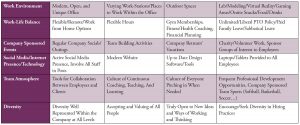Recruitment and retention of new engineering and technical staff are always challenging for structural engineering firms, and this challenge seems to be ever-increasing. Millennials and Generation Z often place a higher value on benefits related to company culture, work environment, flexible working hours, and work-life balance compared to previous generations. By 2025, 75 percent of the workforce will be Millennials and Generation Z. A firm’s success now and in the future will be closely tied to how well they can meet the needs of these younger employees.
The downturn of the economy after the Great Recession in 2008 drove both experienced engineers and those who may have otherwise entered the profession to other fields. Studies have shown that this staffing issue is likely to only become more challenging in the future. Other technical/STEM fields that are more popular in the mainstream culture are often seen as more desirable. These companies are constantly in front of the younger generation considering their college majors and making career choices. It is critically important for our industry to share what we do with elementary, middle, and high school students to interest them in structural engineering as a rewarding career choice.
The Millennials, generally those born between 1981 and 1996, and Generation Z, generally those born between 1996 and 2012, are considered the first “digital natives,” with technology and social media having always been a significant part of their lives. They have been comfortable working with technology in many forms from an early age. These generations are also considered creators, innovators, and entrepreneurs with strong opinions and a strong desire to be heard and have a meaningful impact with their employers. Creating opportunities for these employees to feel open to making suggestions and contributing to innovation will provide a deeper level of engagement.
These issues greatly influence where these employees want to work and how long they ultimately stay. Those in company leadership need to understand these different values and mindsets to recruit and retain these younger employees successfully. It is critically important to a firm’s future and growth to be able to recruit high-quality employees and to be able to keep those employees for the long term. We all understand that a very significant investment of time and financial resources are put into the training and development of young engineers. As such, minimizing staff turnover can significantly impact efficiency, profitability, and a firm’s culture.
The initial hiring phase is crucial. Finding the best fit for the company’s values, culture, and environment will provide the highest likelihood of future success and long-term happiness for both the employee and employer. It is often beneficial to involve multiple people and phases in the interview process to best determine an individual’s fit and be open and honest with the position’s expectations. Often it is not fulfilling the technical skills that proves to be most difficult but instead finding the best fit based on office culture, work environment, and expectations.
The Table is intended to highlight/brainstorm ideas in several broad categories and use it as a template in evaluating a firm’s current benefits and methods used for the recruitment and retention of employees. This can be a starting point to decide which of these benefits best fits a firm’s environment, culture, current staff, and future employees. The list focuses on benefits beyond the typical benefits of salary, insurance, retirement, and profit-sharing. These other benefits are often less costly; however, they are greatly appreciated by staff and serve to provide significant returns on investment related to company culture, work environment, and building a team atmosphere.■

